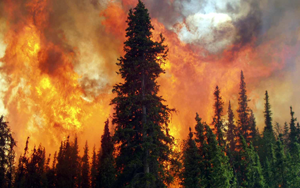 SCI, in collaboration with the National Center for Atmospheric Research (NCAR) and the University of Colorado at Denver have teamed up to tackle the challenges associated with modeling the complexities of wildfires.
SCI, in collaboration with the National Center for Atmospheric Research (NCAR) and the University of Colorado at Denver have teamed up to tackle the challenges associated with modeling the complexities of wildfires.www.openwfm.org
The losses associated with wildfires and the wish to understand, predict, and control wildfires have driven researchers to create ever more detailed and powerful computational models. However, the necessary sophistication and realism requires scientific computing and analysis processes of a complexity that has itself become a hindrance to further progress and education. In addition, the research is done by geographically disperse interdisciplinary groups, and making their models interoperate is a challenge. This project strives to overcome this complexity and challenges to collaboration by state-of-the-art software engineering, visualization, and collaboration tools. The results will find applications in wildfire research, education, training, and management.
The project will provide a web-based service in which a visitor can transparently interact with combinations of fire behavior models, weather models, and data sources, and a software environment where researchers can contribute their software and data. This portal will be seeded with existing software of the investigators and their collaborators, attract new collaborators, and serve as a focus for a vibrant online community. The investigators have already obtained the commitment of a number of prominent fire researchers, educators, and managers to participate.
Immersive, video game-like, dynamic high-performance visualization will be provided as freely downloadable PC client software. The computational engine behind the portal will run on a local computer cluster and remote supercomputers. The project will build on existing community software in numerical weather prediction, component based software engineering, and 3D visualization. It will increase the impact of the research by providing a common open-source environment, new accessible data repositories, and collaboration tools.
Fulfilling this vision will require transformational advances in mathematical modeling of wildland fires, software engineering, and social modes of collaboration. The investigators will build on their recent achievements in these areas to make significant additional contributions in each. New methods in data assimilation will make it possible to incorporate real-time data into
wildfire models. Improvements in component-based software will make it possible to isolate the complexity of computing and analysis into separate models and automate the process of connecting these models. A highly integrated visualization environment will facilitate exploring what-if scenarios in a collaborative data environment. The coupled models will enable a new level of understanding of complexity that goes beyond the wildfire dynamics.
The project will create a new generation of cyber-trained students provided with hands-on experience with state of the art wildfire-weather models and efficient fire management. Its web-based service will be beneficial in education at all levels. It will build tools to minimize the separation between interdisciplinary groups around the world, between research and educational institutions, and between research and operational fire forecasting. The project includes outreach to general public and K-12 education through NCAR events and activities, and integration of the e-community into undergraduate and graduate courses.
